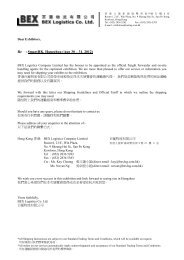Electrochemical Technologies in Wastewater Treatment
Electrochemical Technologies in Wastewater Treatment
Electrochemical Technologies in Wastewater Treatment
Create successful ePaper yourself
Turn your PDF publications into a flip-book with our unique Google optimized e-Paper software.
<strong>Electrochemical</strong> <strong>Technologies</strong> <strong>in</strong><br />
<strong>Wastewater</strong> <strong>Treatment</strong><br />
Guohua CHEN<br />
Department of Chemical and Biomolecular Eng<strong>in</strong>eer<strong>in</strong>g<br />
The Hong Kong University of Science and Technology<br />
Eco Asia Conference (29 / 10 / 2008)
Water Pollution Impacts
<strong>Wastewater</strong> <strong>Treatment</strong> Techniques<br />
Coagulation<br />
Sedimentation<br />
Flotation<br />
Filtration<br />
Biological processes<br />
Advanced oxidation<br />
Adsorption<br />
Membrane processes<br />
�<br />
�<br />
to remove particles<br />
to remove organic<br />
compounds
Electricity Is Not a Stranger
<strong>Electrochemical</strong> methods<br />
Electrodeposition<br />
Electrocoagulation<br />
Electroflotation<br />
Electrooxidation<br />
Electrodis<strong>in</strong>fection<br />
Electroreduction<br />
�<br />
High efficiency<br />
Easy operation<br />
Compact facilities
Electrodeposition for heavy metal recovery<br />
M n+<br />
M n+<br />
-<br />
M<br />
+ ne<br />
ne<br />
M<br />
+
Electrocoagulation<br />
• Generat<strong>in</strong>g coagulant electrically<br />
Al – 3e � Al 3+<br />
Fe – 2e � Fe 2+<br />
• Sludge floated by hydrogen gas<br />
2H 2 O + 2e � H 2 + 2OH -
Applications of Electrocoagulation<br />
• Suspended solids<br />
• Oil & grease<br />
Facilities Required<br />
• Al or Fe plates as electrodes<br />
• DC power supply<br />
• Pump<strong>in</strong>g facility
+ - + -<br />
(a) Horizontal flow<br />
(b) Vertical flow<br />
Electrocoagulation units
The alum<strong>in</strong>um demand and power consumption for remov<strong>in</strong>g pollutants from water<br />
Pollutant Unit quantity Prelim<strong>in</strong>ary purification Purification<br />
Al 3+ , mg E, W�h/m 3 Al 3+ , mg E, W�h/m 3<br />
Turbidity 1 mg 0.04 – 0.06 5 - 10 0.15 – 0.2 20 - 40<br />
Colour 1 unit 0.04 – 0.1 10 - 40 0.1 – 0.2 40 – 80<br />
Silicates 1 mg/SiO2 0.2 – 0.3 20 - 60 1 - 2 100 - 200<br />
Irons 1 mg Fe 0.3 – 0.4 30 - 80 1 – 1.5 100 – 200<br />
Oxygen 1 mg O2 0.5 - 1 40 - 200 2 - 5 80 - 800<br />
Algae 1000 0.006 – 0.025 5 -10 0.02 – 0.03 10 – 20<br />
Bacteria 1000 0.01 – 0.04 5 - 20 0.15 – 0.2 40 - 80
Electroflotation<br />
• Generat<strong>in</strong>g gas bubbles electrically<br />
2H 2 O - 4e � O 2 + 4H +<br />
2H 2 O + 2e � H 2 + 2OH -<br />
• Gas bubbles attach<strong>in</strong>g to flocs<br />
• Float<strong>in</strong>g to top of water surface
Economic parameters <strong>in</strong> treat<strong>in</strong>g oily effluents<br />
<strong>Treatment</strong> type EF DAF IF Settl<strong>in</strong>g<br />
Bubble size, �m 1 - 30 50 - 100 0.5 – 2<br />
Specific electricity consumption,<br />
W/m 3<br />
30 - 50 50 - 60 100 - 150 50 – 100<br />
Air consumption, m 3 /m 3 water 0.02 – 0.06 1<br />
Chemical condition<strong>in</strong>g IC OC + F OC IC + F<br />
<strong>Treatment</strong> time, m<strong>in</strong>utes 10 - 20 30 - 40 30 - 40 100 - 120<br />
Sludge volume as % of treated water 0.05 – 0.1 0.3 – 0.4 3 - 5 7 - 10<br />
Oil removal efficiency, % 99 – 99.5 85 - 95 60 - 80 50 – 70<br />
SS removal efficiency, % 99 – 99.5 90 - 95 85 - 90 90 - 95
Challenges <strong>in</strong> O 2 Evolution Anodes<br />
Economical<br />
Stable<br />
Active<br />
O 2 Evolution Anodes<br />
Pt (wire, mesh, plates)<br />
PbO 2<br />
Graphite<br />
DSA (TiO 2 -RuO 2 ; IrO 2 with Ta 2 O 5 , ZrO 2 or CeO 2 )<br />
DSA (Ti/IrO 2 -Sb 2 O 5 -SnO 2 )
Electrooxidation<br />
Indirect electrooxidation<br />
Cl 2 formation<br />
H 2 O 2 generation<br />
O 3 generation<br />
mediator, Ag 2+<br />
Direct oxidation<br />
OH radicals for complete m<strong>in</strong>eralization
Formation Potential of Typical Chemical Reactants<br />
Oxidants Formation potential<br />
H 2 O/ •OH (hydroxyl radical)<br />
O2 /O3 (ozone)<br />
SO 2-<br />
4 /S2 O 2-<br />
8 (peroxodisulfate)<br />
MnO 2 /MnO 4 2- (permanganate ion)<br />
H2 O/H2 O2 (hydrogen peroxide)<br />
Cl- /ClO -<br />
2 (chlor<strong>in</strong>e dioxide)<br />
Ag + /Ag 2+ (silver (II) ion)<br />
Cl- /Cl2 (chlor<strong>in</strong>e)<br />
Cr3+ /Cr2 O 2-<br />
7 (dichromate)<br />
H 2 O/O 2<br />
(oxygen)<br />
2.80<br />
2.07<br />
2.01<br />
1.77<br />
1.77<br />
1.57<br />
1.50<br />
1.36<br />
1.23<br />
1.23
Basic Requirements of Electrodes<br />
• Good activity<br />
• High stability<br />
• Low cost
Potential of Oxygen Evolution of Anodes<br />
Anode Value, V<br />
Pt<br />
IrO2 Graphite<br />
PbO 2<br />
SnO2 Pb-Sn<br />
Ebonex (Ti4 O7 )<br />
Si/BDD<br />
Ti/BDD<br />
1.3 –1.6<br />
1.6<br />
1.7<br />
1.9<br />
1.9<br />
2.5<br />
2.2<br />
2.3<br />
2.7 – 2.8<br />
Over-potential, V<br />
0.1 – 0.3<br />
0.4<br />
0.5<br />
0.7<br />
0.7<br />
1.3<br />
1.0<br />
1.1<br />
1.5 – 1.6
Analysis of Available Electrodes<br />
• Graphite: unstable, <strong>in</strong>effective, cheap<br />
• Pt, IrO 2 : too expensive, <strong>in</strong>effective<br />
• PbO 2 , SnO 2 : unstable, easy to make<br />
• B-diamond (BDD), effective, expensive
Residual COD, mg/L<br />
1200<br />
1000<br />
800<br />
600<br />
400<br />
200<br />
Oxidation of acetic acid<br />
Ti/BDD<br />
0<br />
0 1 2 3 4 5 6<br />
Charge load<strong>in</strong>g, Ah/L<br />
Ti/Sb 2 O 5 -SnO 2
Residual COD, mg/L<br />
1400<br />
1400<br />
1200<br />
1200<br />
1000<br />
1000<br />
800<br />
800<br />
600<br />
600<br />
400<br />
400<br />
200<br />
200<br />
Oxidation of phenol<br />
Ti/BDD<br />
Ti/BDD<br />
Ti/Sb2O5-SnO2 Ti/Sb2O5-SnO2 0 0 1 2 3 4 5 6 7 8 9 10<br />
0 1 2 3 4 5 6 7 8 9 10<br />
Charge load<strong>in</strong>g, Ah/L<br />
Charge load<strong>in</strong>g, Ah/L
COD, mg/L<br />
1400<br />
1200<br />
1000<br />
800<br />
600<br />
400<br />
200<br />
Oxidation of orange II<br />
Ti/BDD<br />
0<br />
0 1 2 3 4 5 6 7<br />
Charge load<strong>in</strong>g, Ah/L<br />
Ti/Sb 2 O 5 -SnO 2
Reproducibility comparison,<br />
500 mg/l phenol at 100 A/m 2 , 30 o C.
Electrodis<strong>in</strong>fection<br />
• Generat<strong>in</strong>g chlor<strong>in</strong>e electrically<br />
2Cl - -2e � Cl 2<br />
(anode)<br />
2H 2 O + 2e � H 2 + 2OH - (cathode)<br />
• Generat<strong>in</strong>g OH radicals electrically<br />
(similar to electrooxidation)
Log-kill of bacteriophage MS2 versus time at different<br />
currents at salt content 1% NaCl by mass
Comparison between the log-kill of bacteriophage MS2 <strong>in</strong><br />
the EC and PC systems at currents of 0.05 and 0.15 A
Electroreduction<br />
• Direct reduction on the surface of cathode<br />
M n+ + ne � M (cathode)<br />
• Mediated reduction by H 2 generated<br />
2H 2 O + 2e � H 2 + 2OH- (cathode)<br />
• Mediated reduction by Fe 2+ generated<br />
Fe - 2e � Fe 2+ (anode)
compressed air<br />
<strong>in</strong>fluent solution<br />
Fe plate<br />
draft tube<br />
EC<br />
EF1<br />
EF2<br />
Anode(oxidation) : Fe ⇔ Fe2+ 2e− Mediated reduction: Cr6+ + 3Fe2+ ⇔ Cr3+ + 3Fe3+ Cathode(reduction) : 2H2O + 2e− ⇔ H2 + 2OH− Co-precipitation : Cr3+ + 3OH− ⇔ Cr(OH) 3<br />
Fe3+ + 3OH− ⇔ Fe(OH) 3<br />
Fe2+ + 2OH− ⇔ Fe(OH) 2<br />
effluent solution<br />
(1)<br />
(2)<br />
(3)<br />
(4)<br />
(5)<br />
(6)
CONCLUSIONS<br />
• Electrodeposition established<br />
• Electrocoagulation works<br />
• Electrocoagulation & electroflotation works better<br />
• BDD is an excellent anode for electrooxidation<br />
• Electrodis<strong>in</strong>fection outperforms pump chlor<strong>in</strong>e system<br />
• Electroreduction is f<strong>in</strong>d<strong>in</strong>g more application
Acknowledgements<br />
Professor Po Lock Yue<br />
Professor P<strong>in</strong>g Gao<br />
Professor Chii Shang<br />
Dr. Xuem<strong>in</strong>g Chen<br />
Mr. Feng Shen<br />
Mr. Yuan Tian<br />
Dr. Liang Guo<br />
Miss Qian Fang<br />
Mr. Johnston Ralston<br />
Mr. Jiaqi Zheng<br />
F<strong>in</strong>ancial Supports from ECF, RGC, DAG are appreciated
Thank you for your attention










